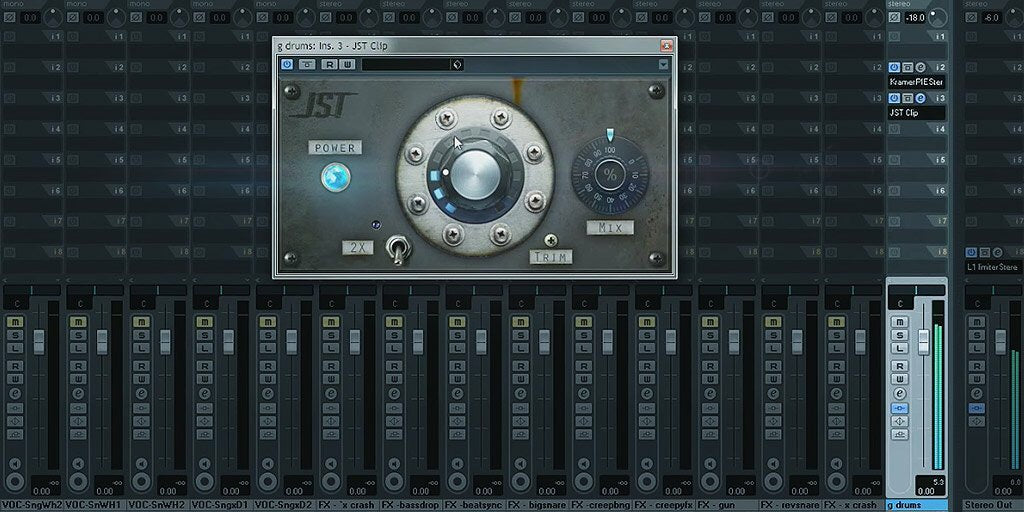Your Gain Knob IS NOT a Volume Knob
I’ll say it once more for the people that left their Master Volume maxed out while messing around with their Gain… Your Gain Knob is absolutely, 100%, indisputably NOT a volume knob.
If you’ve already accepted this as the honest and complete truth (and you’re already a master of gain staging), this post probably isn’t for you. You can go back to using Gain Reduction, JST Clip, or literally any other plugin with a Gain Knob free of judgment from the JST team. Have fun and happy mixing!

For the rest of you – stick around. We’re going to go through the ups and downs of gain and how you’re probably using it wrong in your mixes. Don’t worry… by the time we’re done, you’ll be a seasoned vet when it comes to gain staging and making the most out of the gain controls on everything you touch (possibly even more so than the overconfident engineers we just kicked out of the room).
A Confession About Gain
If were going to discuss gain, I need to approach the conversation from a place of complete transparency. For that to happen, I need to start with a confession:
“I have used a Gain Knob to increase volume and will likely do it again.”
Increasing the gain on a guitar amp or plugin will almost always result in a perceived or actual volume boost. I’ve accepted this as the truth, but I continue to do it anyway.
There’s a difference between ignorance and acceptance though. While my main intent using the gain is not the volume boost, it’s a good side effect to have when you can account for and anticipate it.

Engineers and producers need to retrain their ears to differentiate if something sounds better or if it sounds louder. If the answer is both, that’s completely fine, as long as the increased volume is desirable. If it’s not, you should be level matching the output of the plugin for consistency.
Our problems with gain have little to do with anything it’s doing wrong, and everything to do with the results we expect to see.
When Should You Use Gain?
Gain determines how much of the signal you’re feeding into the processor, which in turn, affects how that processor handles the information you’re feeding it. Many gain-focused processors are really just fixed-setting compressors or limiters with a Gain Knob.
Not to discredit the capabilities or functionality of these plugins in any way – processors like JST Clip have algorithms that are optimized to function at their best by locking in on certain parameters and letting the Gain do the rest. Again, it’s about accepting what you’re hearing as it is, not using it as a glorified, less effective volume knob.

Other plugins use gain as a late addition, sometimes as a way to add a level of harmonic distortion to your signal. These varying uses of gain tend to cloud the waters a bit on nailing down a definitive definition for gain. Instead, it’s easier to say what gain is not: a volume knob.
Gain Staging
Gain staging is a process that professional engineers handle all the time, but many do it as second nature or a course of habit. Some don’t even know it as gain staging at all, but rather, it’s just a “best practice” when recording or mixing.
At its core, gain staging is the process of making sure you’re feeding appropriate levels from one plugin to the next, from the start of your signal chain to the mix bus. All plugins have nominal ranges they can operate in, and maintaining good gain staging between them ensures you’re getting the intended sound out of each one.
Imagine for a moment you’re hitting a tape machine a few dB hotter than intended. The tape might at first start to give you a saturated sound at risk of losing a bit of dynamic range.

Now imagine that same tape machine getting slammed with levels way too high to even capture. You’ll quickly start to hear the audio quality breakdown as the tape machine struggles to record the signal. The same type of breakdown occurs when you feed a signal that’s too loud into a plugin.
By stepping back and giving yourself plenty of headroom, you can ensure everything can run optimally. This takes a balancing act of both gain AND volume as your signal passes between processors. While plugins have been built to withstand quite the barrage of various levels, you’ll never get to see their full potential without proper gain staging.
Gaining Momentum
The more you start to understand how gain staging and gain knobs affect your processors, the more you’ll want to experiment with them. I remember using a similar signal chain time and time again because it just sounded “right”, so much so that I boxed myself into a corner creatively.
As I started to understand how to rebuild my gain staging, a whole slew of signal chains started to open up. I could reorder, stack multiple processors & more without the constraints I had before. While I’ve still got my favorites, I can make wiser mix decisions when I need to find new ways to treat various mix problems.
Have you found your workflow changing as you’ve learned how certain plugins interact with each other? If so, come share your experience with us in the Joey Sturgis Tones Forum. We’re always interested in hearing how our plugins are getting used, and how they’re interacting with the rest of your mix!
See you there!









